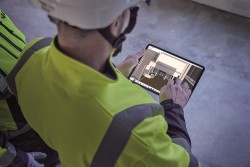Both BIM and offsite are two areas of construction frequently dubbed as holding the key to the industry’s more efficient and digital future. But what happens when the two come together? Chris Gatehouse, Regional Account Manager at Trimble explores the value that BIM can deliver to the offsite industry.
The benefits of offsite manufacturing and construction are of course well known, being frequently proclaimed: from the time and cost savings and offer of greater programme certainties to better construction quality and reduced material waste. Given this, it is perhaps no surprise that offsite is often heralded as being the future of the construction industry, with the UK Government delivering a clear push on modern construction methods, including offsite fabrication, in its aim of building better, faster and greener. Of course, offsite is not alone in this vision of the industry, for Building Information Modelling (BIM) and other digital construction technology is also set to have an important role to play, facilitating a more efficient, coordinated and reliable construction process.
So, what happens when you combine these two construction industry players? In many ways, BIM and offsite are perfect partners. With a BIM workflow, the value and benefits of offsite that we are already seeing and experiencing can now be leveraged and pushed even further, helping contractors to deliver offsite projects to an even higher standard and produce a new generation of sustainable and impressive buildings.
Of course, perhaps one of the key requirements of any offsite construction project, is the need for accuracy. With the aim for all structural components, whether it be a loadbearing light metal frame or volumetric pod, to be fabricated and assembled offsite, before being lifted and fixed into place on site, ensuring high levels of precision and exact coordination between components is critical. Failure to satisfy these tight tolerances runs the risk of offsite’s time-saving benefits being lost, with the need for extensive rework or even re-fabrication. In addition to the subsequent delays to the overall project delivery, this could also cause costs to go up dramatically, as well as resulting in material wastage – again going against the core of offsite construction.
This is where BIM comes into play, renowned for its information-rich and highly accurate 3D models. Given the visualisation enabled by the 3D model, it enables you to see the proposed structure before you even get to site, to build it before you actually build it. In turn, this can all provide confidence in the structural design, as well as the assurance that all components work and integrate together correctly.
Here, clash detection is another helpful feature of a model-based software, with the ability to automatically check a model for any potential design clashes and provide engineers an opportunity to resolve the issue before the project reaches the fabrication stage. Without BIM, this process would be wholly reliant on project teams manually spotting the issue, with the potential for human error, especially on projects with particular complex components or connections.
This theme of accuracy carries into another aspect of BIM, mainly the idea of the 3D model acting as the central source of information. Once the main model is finalised, clash checked and approved, all documentation, including quantity take-offs, production schedules, fabrication drawings and project reports, is automatically generated using the data stored within the 3D model. This integrated flow of accurate and information-rich data throughout the construction sequence, from detailing through to fabrication and on-site assembly, can be invaluable, facilitating a more streamlined and efficient process and, in turn, helping to further push the value of offsite construction.
Another critical factor on any offsite project is the need for effective coordination between disciplines and stakeholders. While co-ordination and collaboration are important on any construction project, whether traditionally built or otherwise, it is perhaps especially critical on a project utilising offsite methods of fabrication and assembly. For example, light steel framing and volumetric pods can both feature any great number of interrelating components and disciplines, from structural to building services, with the need for everything to come together perfectly once assembled on-site.
Here, again, a model-based workflow can help. While conversation around BIM may primarily focus on the productivity and efficiency benefits, the enhanced levels of co-ordination, collaboration and communication that it can also offer are perhaps just as significant. From the 3D model acting as a central source of information and the interoperability between software, to the development of cloud-based software – such as Trimble Connect – providing all project teams with a means of accessing the data relevant to them.
So, what about the future? As the offsite industry advances and evolves, so too does the world of BIM and digital construction.
Perhaps one of the latest developments within offsite is the idea of standardisation or the ‘Kit of Parts’ approach. Ideal for public buildings, such as schools, hospitals and prisons, it is evidently set to become a critical part of the offsite sector, with the benefits of standardisation already heavily featuring within the UK Government’s two newly published documents – the Construction Playbook and the National Infrastructure Strategy. In fact, it is already happening, with the pioneering SEISMIC project being one example.
Running in line with this, BIM again looks set to help the offsite sector deliver, with the development of parametric design tools. Parametric design, or data-driven design, involves inputting the required rules, parameters and algorithms and having the computer software then generate the design output. While more commonly associated with creating organic and complex shapes, parametric design is perhaps equally suited to the standard and repetitive – making it ideal for the standardisation approach.
Despite their differences, offsite and BIM are also in many ways the same, helping to deliver buildings of the future more efficiently, smartly and sustainably. Combining the two, therefore, can only be a positive thing, bringing even more power and value to construction.
To read full article and for more news, check out the latest Offsite Magazine









